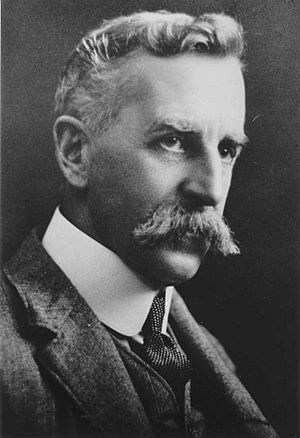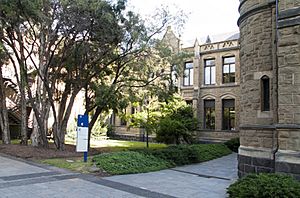Walter Baldwin Spencer facts for kids
Quick facts for kids
Sir Walter Baldwin Spencer
|
|
|---|---|
 |
|
| Born | 23 June 1860 Stretford, Lancashire
|
| Died | 14 July 1929 (aged 69) Hoste Island, Chile
|
| Nationality | British |
| Awards | Clarke Medal (1923) |
| Scientific career | |
| Fields | Anthropologist |
Sir Walter Baldwin Spencer (born June 23, 1860 – died July 14, 1929) was an important British-Australian scientist. He was an evolutionary biologist, an anthropologist, and an ethnologist. This means he studied how living things change over time, human societies, and different cultures.
Spencer is famous for his work with Aboriginal peoples in Central Australia. He also helped us understand more about ethnography, which is the study of different cultures. He worked closely with another scientist named Frank Gillen. Spencer also started the study of zoology (the study of animals) at the University of Melbourne in Australia. He was honored as a Knight in 1916.
Contents
Early Life and Education
Spencer was born in Stretford, England, on June 23, 1860. He went to school in Old Trafford and also studied drawing at the Manchester School of Art.
In 1879, Spencer started studying at Owens College (University of Manchester). Here, he became very interested in how living things evolve. He later earned a degree in biology from the University of Oxford in 1884. While at Oxford, he attended lectures by Edward Burnett Tylor, a famous anthropologist. This sparked Spencer's lifelong interest in studying human cultures.
After graduating, Spencer worked as a teaching assistant. He helped move a large collection of anthropological items to the Pitt Rivers Museum at Oxford University. In 1886, he received a special fellowship at Lincoln College, Oxford.
Career and Discoveries
Moving to Melbourne and New Beginnings
Spencer had already written several scientific papers, including one about the "Pineal eye" in lizards, which was very interesting to other scientists. In 1887, he was chosen to be a professor of biology at Melbourne University in Australia.
He arrived in Australia in March 1887 and immediately began setting up the new biology department. He received money to build new classrooms and laboratories. Spencer was a great teacher and organizer. He also took part in many university activities and was involved with scientific groups like the Royal Society of Victoria.
Exploring Australia and Studying Cultures
In 1894, Spencer joined the Horn Expedition, a scientific trip that explored Australia. During this trip, he met Francis James Gillen in Alice Springs. Gillen was a telegraph station master who knew a lot about the local Aboriginal peoples. This meeting started a very important partnership. The expedition covered about 2,000 miles, and Spencer helped write the report about it, which was published in 1896.
In 1896, Spencer returned to Alice Springs to work more with Gillen. Their studies led to their first book, Native Tribes of Central Australia, published in 1899. They continued their work during the next two years. They gathered a lot of information about tribal customs. While Spencer's records are very valuable, it's important to know that his views on Aboriginal people were from a different time and are not accepted today.
Spencer also became a trustee of the public library in 1895. In 1899, he became the honorary director of the national museum. He worked hard to organize the museum and gave it many valuable collections of Aboriginal objects he had gathered during his travels. In 1900, he was elected a fellow of the Royal Society in London.
In 1900 and 1901, Spencer and Gillen spent 12 months traveling from Oodnadatta to the Gulf of Carpentaria. An artist and interpreter named Jim Kite, also known as Erlikilyika, helped them. Their experiences became their next book, The Northern Tribes of Central Australia, published in 1904.
University Leadership and Further Expeditions
From 1904 to 1911, Spencer was the president of the professorial board at Melbourne University. This meant he had a lot of administrative work because there was no paid vice-chancellor at the time. He also supported student sports activities. He was even the President of the Victorian Football League from 1919 to 1925.
In 1911, the Australian government asked him to lead an expedition to the Northern Territory to study conditions there. The next year, he published Across Australia and also became a special commissioner and chief protector for Aboriginal people. His experiences from this trip were written in his book Native Tribes of the Northern Territory of Australia (1914).
Spencer continued his work for the national museum. In 1916, he was made a Knight Commander of the Order of St Michael and St George (KCMG) for his contributions. He resigned from his professorship in 1919. In 1923, he received the Clarke Medal, a special award for scientific achievement.
Different Views on Aboriginal Cultures
Spencer had different ideas about the Aranda people (now called Arrernte) than missionary Carl Strehlow. Spencer believed their culture was declining, while Strehlow saw their creativity and future. Strehlow's son, Ted Strehlow, later wrote that Spencer and Gillen sometimes struggled because they didn't speak the local languages fluently. This meant they might not have fully understood everything from the Indigenous people.
A debate happened among anthropologists because Strehlow's book, Die Aranda- und Loritja-Stämme in Zentral-Australien (published from 1907 to 1920), challenged some of Spencer and Gillen's findings. The main argument was whether Aboriginal people were "primitive" or if their culture had changed over time.
Spencer also tried to close down Strehlow's Hermannsburg Mission between 1912 and 1922. In a report, Spencer suggested that Aboriginal children should be taken away from their parents and raised in special reserves. He believed this would help them adapt to a different way of life. However, the Administrator of the Northern Territory, John A. Gilruth, visited the mission and decided that the Strehlows and their work should continue.
Later Travels and Books
Spencer visited Central Australia two more times, in 1923 and 1926. These trips helped him review his earlier studies. His book The Arunta: a Study of a Stone Age People (1927) confirmed his earlier ideas. Another book, Wanderings in Wild Australia, was published a year later and was written in a more popular style.
In 1927, Spencer went to London to oversee the printing of these books. Even though he was almost 70, he traveled to Magallanes and Tierra del Fuego in South America in 1929 for another expedition.
Personal Life
Spencer married Mary Elizabeth ('Lillie') Bowman in January 1887. They had two daughters and a son who sadly died as a baby.
Death
Sir Walter Baldwin Spencer died on July 14, 1929, from heart failure during his expedition to Tierra del Fuego, which is in Chile and Argentina. He was buried in Magallanes, Chile.
Legacy and Recognition
In 2009, a project was started to collect and digitize all the original work of Spencer and Gillen.
The Baldwin Spencer Building at the University of Melbourne was built in 1888 and named after Spencer in 1920. It is now a protected heritage site.
In 1976, Australia Post released a postage stamp with Spencer's picture on it.
Two species of Australian lizards are named after Spencer: Pseudemoia spenceri and Varanus spenceri.
Selected Works
- Spencer, Walter Baldwin; Gillen, Francis James (2014). The Native Tribes of Central Australia. Originally published: London, Macmillan and Co.,1899. University of Adelaide. https://ebooks.adelaide.edu.au/s/spencer/baldwin/s74n/complete.html.
- Spencer, Walter Baldwin; Gillen, F. J. (1904). The Northern Tribes of Central Australia. London: Macmillan and Co.. OL6943256M.
- Spencer, Walter Baldwin (1924). Wanderings in Wild Australia. London: Macmillan and Co.. OL13575672M.
- Spencer, Walter Baldwin (1931). Spencer's Last Journey. Being a Journal of an Expedition to Tierra Del Fuego by the Late Sir Baldwin Spencer. With a Memoir. Oxford: Clarendon Press. Edited by R. R. Marett and T. K. Penniman.


